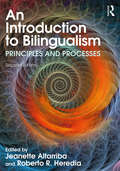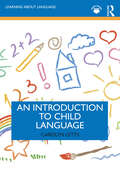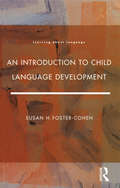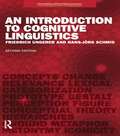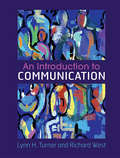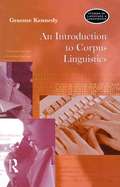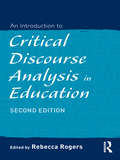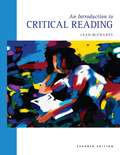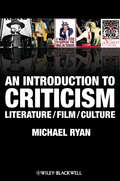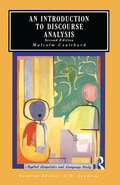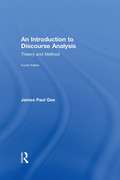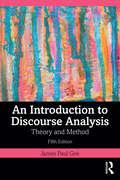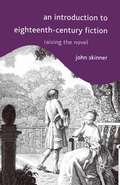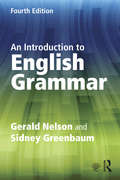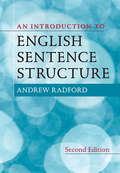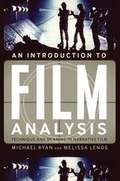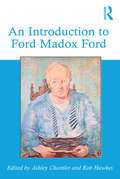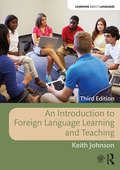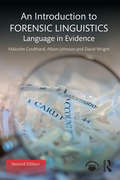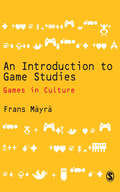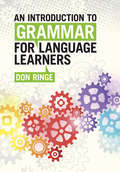- Table View
- List View
An Introduction to Bilingualism: Principles and Processes
by Jeanette Altarriba and Roberto R. HerediaThe study of bilingualism and all of its aspects – from theory and models to social approaches and their practical applications – forms the cornerstone of the 2nd edition of this work. The chapters cover the latest advancements in the domains of psycholinguistics, neuroscience, creativity, and executive functioning. Contributions, new to this edition, offer the reader the most up-to-date research on lifespan and developmental issues. The work also provides insight into how human language is processed by all, not just by bilingual and multilingual speakers.This text is ideal for senior undergraduate and graduate courses in psycholinguistics and the psychology of language, especially those with an emphasis on bilingualism or second language learning.
An Introduction to Child Language (Learning about Language)
by Carolyn LettsThis accessible and inclusive new textbook introduces Child Language Acquisition (CLA), with unique coverage of bilingual and early second language development as well as first languages. The majority of children worldwide will grow up to be bi- or multilingual, and early second language acquisition is a very common experience for migrant children and those in more well-established ethnic minority communities across the world. The book explores the major stages of child language development below the age of five years, covering social context, early words, combining words, inflections and function words, complexity, and use of language, but also some of the major developments that take place post five years.Including recent developments in the area, this introduction:• Emphasises the interactive development of the component skills involved in language and the wider skills on which language depends• Incorporates bilingual language development throughout, covering both two first languages and early naturalistic second language acquisition• Takes a crosslinguistic and cross-cultural approach, considering the role of input and child directed speech in the light of recent debate about links between socio-economic status and CLA and supposed ‘deficient’ language-learning environments for some groups of childrenSupported with examples taken from child language data and experimental studies, as well as exercises and activities, this student-friendly text is an essential course textbook for any module on child language acquisition.
An Introduction to Child Language Development (Learning about Language)
by Susan H.Foster- CohenThis volume introduces the field of child language development studies, and presents hypotheses in an accessible, largely non-technical language, aiming to demonstrate the relationship between these hypotheses and interpretations of data. It makes the assumption that having a theory of language development is as important as having reliable data about what children say and understand, and it advocates a combination of both `rationalist' and more 'empiricist' traditions. In fact, the author overtly argues that different traditions provide different pieces of the picture, and that taking any single approach is unlikely to lead to productive understanding. Susan Foster-Cohen explores a range of issues, including the nature of prelinguistic communication and its possible relationship to linguistic development; early stages of language development and how they can be viewed in the light of later developments; the nature and role of children's experience with the language(s) around them; variations in language development due to both pathological and non-pathological differences between children, and (in the latter case) between the languages they learn; later oral language development; and literacy. The approach is distinctly psycholinguistic and linguistic rather than sociolinguistic, although there is significant treatment of issues which intersect with more sociolinguistic concerns (e.g. literacy, language play, and bilingualism). There are exercises and discussion questions throughout, designed to reinforce the ideas being presented, as well as to offer the student the opportunity to think beyond the text to ideas at the cutting edge of research.The accessible presentation of key issues will appeal to the intended undergraduate readership, and will be of interest to those taking courses in language development, linguistics, developmental psychology, educational linguistics, and speech pathology. The book will also serve as a useful introduction to students wishing to pursue post-graduate courses which deal with child language development.
An Introduction to Cognitive Linguistics (Learning about Language)
by Friedrich Ungerer Hans-Jorg SchmidLearning About Language is an exciting and ambitious series of introductions to fundamental topics in language, linguistics and related areas. The books are designed for students of linguistics and those who are studying language as part of a wider course. Cognitive Linguistics explores the idea that language reflects our experience of the world. It shows that our ability to use language is closely related to other cognitive abilities such as categorization, perception, memory and attention allocation. Concepts and mental images expressed and evoked by linguistic means are linked by conceptual metaphors and metonymies and merged into more comprehensive cognitive and cultural models, frames or scenarios. It is only against this background that human communication makes sense. After 25 years of intensive research, cognitive-linguistic thinking now holds a firm place both in the wider linguistic and the cognitive-science communities.An Introduction to Cognitive Linguistics carefully explains the central concepts of categorizaÂtion, of prototype and gestalt perception, of basic level and conceptual hierarchies, of figure and ground, and of metaphor and metonymy, for which an innovative description is provided. It also brings together issues such as iconicity, lexical change, grammaticalization and language teaching that have profited considerably from being put on a cognitive basis.The second edition of this popular introduction provides a comprehensive and accessible up-to-date overview of Cognitive Linguistics: Clarifies the basic notions supported by new evidence and examples for their application in language learning Discusses major recent developments in the field: the increasing attention paid to metonymies, Construction Grammar, Conceptual Blending and its role in online-processing. Explores links with neighbouring fields like Relevance Theory Uses many diagrams and illustrations to make the theoretical argument more tangible Includes extended exercises Provides substantial updated suggestions for further reading.
An Introduction to Communication
by Richard West Lynn H. TurnerPrioritizing brevity and clarity, this textbook introduces the study of communication through examples and applications of communication in a variety of contexts. With a unique focus on diversity and the impact of culture, each chapter opens with a case study that identifies a communication challenge, which the chapter addresses throughout, and concludes with questions that respond to that challenge. A consistent, organized structure with numerous features including fundamental issues, questions for understanding and analysis, theoretical insight (examining a particular relevant theory), and a skill set section, easily guides you through the foundations of the study of communication. Cross-referencing between chapters demonstrates the multidimensional nature of communication and the everyday talk sections demonstrate how each topic relates to technology, the workplace, or health issues. Offering a wealth of diverse examples from students' personal, professional, and online lives, this book teaches skills allowing students from all academic backgrounds to understand communication.
An Introduction to Corpus Linguistics (Studies in Language and Linguistics)
by Graeme KennedyThe use of large, computerized bodies of text for linguistic analysis and description has emerged in recent years as one of the most significant and rapidly-developing fields of activity in the study of language. This book provides a comprehensive introduction and guide to Corpus Linguistics. All aspects of the field are explored, from the various types of electronic corpora that are available to instructions on how to design and compile a corpus. Graeme Kennedy surveys the development of corpora for use in linguistic research, looking back to the pre-electronic age as well as to the massive growth of computer corpora in the electronic age.
An Introduction to Critical Discourse Analysis in Education
by Rebecca RogersAccessible yet theoretically rich, this landmark text introduces key concepts and issues in critical discourse analysis and situates these within the field of educational research. The book invites readers to consider the theories and methods of three major traditions in critical discourse studies – discourse analysis, critical discourse analysis, and multimodal discourse analysis -- through the empirical work of leading scholars in the field. Beyond providing a useful overview, it contextualizes CDA in a wide range of learning environments and identifies how CDA can shed new insights on learning and social change. Detailed analytic procedures are included – to demystify the process of conducting CDA, to invite conversations about issues of trustworthiness of interpretations and their value to educational contexts, and to encourage researchers to build on the scholarship in critical discourse studies. This edition features a new structure; a touchstone chapter in each section by a recognized expert (Gee, Fairclough, Kress); and a stronger international focus on both theories and methods. NEW! Companion Website with Chapter Extensions; Interviews; Bibliographies; and Resources for Teaching Critical Discourse Analysis.
An Introduction to Critical Reading
by Leah MccraneyThis unique college reading text gives students experience reading and evaluating poetry, short stories, essays, and textbook chapters. An innovative Instructor's Manual gives instructors a wealth of teaching ideas and background material on each piece with a focus on critical thinking.
An Introduction to Criticism
by Michael RyanAn accessible and thorough introduction to literary theory and contemporary critical practice, this book is an essential resource for beginning students of literary criticism.Covers traditional approaches such as formalism and structuralism, as well as more recent developments in criticism such as evolutionary theory, cognitive studies, ethical criticism, and ecocriticismOffers explanations of key works and major ideas in literary criticism and suggests key elements to look for in a literary textAlso applies critical approaches to various examples from film studiesHelps students to build a critical framework and write analytically
An Introduction to Discourse Analysis (Applied Linguistics and Language Study)
by Malcolm Coulthard C. N. CondlinThe central concern of this book is the analysis of verbal interaction or discourse. This first six chapters report and evaluate major theoretical advances in the description of discourse. The final chapters demonstrate how the findings of discourse analysis can be used to investigate second-language teaching and first-language acquisition and to analyse literary texts.
An Introduction to Discourse Analysis: Theory and Method
by James Paul GeeDiscourse analysis considers how language, both spoken and written, enacts social and cultural perspectives and identities. Assuming no prior knowledge of linguistics, An Introduction to Discourse Analysis examines the field and presents James Paul Gee's unique integrated approach which incorporates both a theory of language-in-use and a method of research. An Introduction to Discourse Analysis can be used as a stand-alone textbook or ideally used in conjunction with the practical companion title How to do Discourse Analysis: A Toolkit. Together they provide the complete resource for students studying discourse analysis. Updated throughout, the fourth edition of this seminal textbook also includes two new chapters: 'What is Discourse?' to further understanding of the topic, as well as a new concluding section. A new companion website www.routledge.com/cw/gee features a frequently asked questions section, additional tasks to support understanding, a glossary and free access to journal articles by James Paul Gee. Clearly structured and written in a highly accessible style, An Introduction to Discourse Analysis includes perspectives from a variety of approaches and disciplines, including applied linguistics, education, psychology, anthropology and communication to help students and scholars from a range of backgrounds to formulate their own views on discourse and engage in their own discourse analysis. This is an essential textbook for all advanced undergraduate and postgraduate students of discourse analysis.
An Introduction to Discourse Analysis: Theory and Method
by James Paul GeeThis bestselling textbook provides a comprehensive guide to conducting discourse analysis. The book outlines Gee’s approach, which involves examining how language is used in context to construct meaning, identities, relationships, and social practices.The theoretical framework is built around seven "building tasks" that language performs: significance, practices, identities, relationships, politics, connections, and sign systems and knowledge. Gee introduces six "tools of inquiry" for analyzing these tasks: situated meanings, social languages, figured worlds, intertextuality, Discourses, and Conversations.Methodologically, Gee emphasizes the importance of context and the reciprocal relationship between language and context. He discusses transcription, outlines the components of an "ideal" discourse analysis, and addresses issues of validity.The book provides practical guidance on analyzing various aspects of language, such as intonation units, stanzas, and the overall organization of oral and written texts. Gee uses interview data to demonstrate how identities and socially situated meanings are constructed through language.This new edition is updated throughout with new examples and a new chapter on multimodal discourse analysis, demonstrating how Gee’s approach can be applied to texts that combine language with other modes of communication, like images or video. Overall, the book equips readers with a robust toolkit for systematically analyzing discourse.
An Introduction to Eighteenth-Century Fiction: Raising the Novel
by John SkinnerThe formal and expressive range of canonic eighteenth-century fiction is enourmous: between them Defoe, Richardson, Fielding, Smollett and Sterne seem to have anticipated just about every question confronting the modern novelist; and Aphra Behn even raises a number of issues overlooked by her male successors. But one might also reverse the coin: much of what is present in these writers will today seem remote and bizarre. There is, in fact, only one novelist from the 'long' eighteenth century who is not an endangered species outside the protectorates of university English departments: Jane Austen. Plenty of people read her, moreover, without the need for secondary literature. These reservations were taken into account in the writing of this book. An Introduction to Eighteenth Century Fiction is a comprehensive and accessible introduction to English fiction from Aphra Behn to Jane Austen. It deals with novel criticism, canon formation and relations between genre and gender. The second part of the book contains an extensive discussion of Richardson and Fielding, followed by paired readings of major eighteenth-century novels, juxtaposing texts by Behn and Defoe, Sterne and Smollett, Lennox and Burney among others. The various sections of the book, and even the individual chapters, may be read independently or in any order. Works are discussed in a way intended to help students who have not read them, and even engage with some who never will. The author consumes eighteenth-century fiction avidly, but has tried to write a reader-friendly survey for those who may not.
An Introduction to English Grammar
by Sidney Greenbaum Gerald NelsonAn Introduction to English Grammar provides a comprehensive overview of all aspects of English grammar. The first part of the book ('The Grammar') provides a step-by-step introduction to the key topics in English grammar. The second part ('The Applications') shows how a grasp of these topics can be helpful in resolving usage problems, in developing a clear writing style, and in mastering punctuation and spelling. A whole chapter, 'English in Use', is devoted to illustrating the grammatical features of a wide range of modern text types, including emails, Facebook pages, and 'tweets'. It also looks at the special grammatical features of English in everyday conversation. Each chapter is followed by two sets of exercises. The first set can be used in self-study or in the classroom. The second set deals with more advanced topics, and can be used for classroom discussion or essay writing. This fourth edition has been fully revised and updated and includes: clearer descriptions and improved presentation new material on word structure and word formation new exercises, examples and extracts updated further reading Assuming no prior knowledge of English grammar, this book is ideal for beginning students on a one-semester course and provides everything a student needs on the theory and practice of English usage. A comprehensive Glossary of grammatical terms is included and a website provides invaluable additional exercises.
An Introduction to English Grammar
by Sidney Greenbaum Gerald NelsonAn Introduction to English Grammar provides a comprehensive overview of all aspects of English grammar. The first part of the book (‘The Grammar’) provides a step-by-step introduction to the key topics in English grammar. The second part (‘The Applications’) shows how a grasp of these topics can be helpful in resolving usage problems, in developing a clear writing style, and in mastering punctuation and spelling. A whole chapter, ‘English in Use’, is devoted to illustrating the grammatical features of a wide range of modern text types, including emails, Facebook pages, and ‘tweets’. It also looks at the special grammatical features of English in everyday conversation. Each chapter is followed by two sets of exercises. The first set can be used in self-study or in the classroom. The second set deals with more advanced topics, and can be used for classroom discussion or essay writing. This fourth edition has been fully revised and updated and includes: clearer descriptions and improved presentation new material on word structure and word formation new exercises, examples and extracts updated further reading Assuming no prior knowledge of English grammar, this book is ideal for beginning students on a one-semester course and provides everything a student needs on the theory and practice of English usage. A comprehensive Glossary of grammatical terms is included and a website provides invaluable additional exercises.
An Introduction to English Sentence Structure
by Andrew RadfordThis new edition of Andrew Radford's outstanding resource for students is a step-by-step, practical introduction to English syntax and syntactic principles, written by a globally-renowned expert in the field. Assuming little or no prior background in syntax, Radford outlines key concepts and how they can be used to describe various aspects of English sentence structure. Each chapter contains core modules focusing on a specific topic, a summary recapitulating the main points of the chapter, and a bibliographical section providing references to original source material. This edition has been extensively updated, with new analyses, exercise materials, references and a brand-new chapter on adjuncts. Students will benefit from the online workbook, which contains a vast amount of exercise material for each module, including self-study materials and a student answerbook for these. Teachers will value the extensive PowerPoints outlining module contents and the comprehensive teacher answerbook, which covers all workbook and PowerPoint exercises.
An Introduction to Film Analysis: Technique and Meaning in Narrative Film
by Michael Ryan Melissa LenosAn Introduction to Film Analysis combines an introduction to filmmaking technique with rigorous and comprehensive training in film interpretation. Composed in an accessible style yet conversant with the latest, most advanced critical theories and methods, this innovative textbook can be reliably used on both the undergraduate and the graduate level. The book begins with chapters that familiarize students with the basic components of film technique. It connects technique to meaning and demonstrates, through numerous examples, how particular uses of film technique generate different meanings. Students will learn how films are made and how values are promoted, ideas communicated, and rhetorical arguments advanced through film technique. The second part of the book covers a range of interpretive methods, theories, and concerns. In each section, the author offers a sample reading of a film, followed by an "interpretive exercise" with suggestions for students to use in performing their own film interpretation. Carefully structured, beautifully written, and illustrated throughout, An Introduction to Film Analysis provides a thorough grounding in the subject for students around the world.
An Introduction to Ford Madox Ford
by Rob Hawkes Ashley ChantlerFor students and readers new to the work of Ford Madox Ford, this volume provides a comprehensive introduction to one of the most complex, important and fascinating authors. Bringing together leading Ford scholars, the volume places Ford's work in the context of significant literary, artistic and historical events and movements. Individual essays consider Ford's theory of literary Impressionism and the impact of the First World War; illuminate The Good Soldier and Parade's End; engage with topics such as the city, gender, national identity and politics; discuss Ford as an autobiographer, poet, propagandist, sociologist, Edwardian and modernist; and show his importance as founding editor of the groundbreaking English Review and transatlantic review. The volume encourages detailed close reading of Ford's writing and illustrates the importance of engaging with secondary sources.
An Introduction to Foreign Language Learning and Teaching
by Keith JohnsonAn Introduction to Foreign Language Learning and Teaching presents an engaging, student-friendly guide to the fields of foreign language learning and teaching. For students beginning their study of these fields, the book provides essential background information, dealing with language learning and teaching in a clear and comprehensible way. An Introduction will also be of value to teachers in training and those already working in the field, providing an up-to-date overview which focuses on contemporary issues while at the same time providing an important historical perspective. The book covers both theoretical and practical aspects of the field and provides suggestions throughout for discussion and workshop activities. Matters related to classroom and task-based teaching are dealt with at length, making the book suitable for use on practical training courses, especially where a degree of theoretical background is also required. Although most of the examples used deal with English as a foreign language, the book offers a suitable introduction for teachers of any foreign language. In this age of unfettered global communication the teaching and learning of foreign languages have never been more important. An Introduction to Foreign Language Teaching and Learning will give you the head start you need to get ahead of the field.
An Introduction to Foreign Language Learning and Teaching (Learning about Language)
by Keith JohnsonAn Introduction to Foreign Language Learning and Teaching provides an engaging, student-friendly guide to the field of foreign language learning and teaching. Aimed at students with no background in the area and taking a task-based approach, this book: introduces the theoretical and practical aspects of both learning and teaching; provides discussion and workshop activities throughout each chapter of the book, along with further reading and reflection tasks; deals with classroom- and task-based teaching, and covers lesson planning and testing, making the book suitable for use on practical training courses; analyses different learning styles and suggests strategies to improve language acquisition; includes examples from foreign language learning in Russian, French, and German, as well as English; is accompanied by a brand new companion website at www.routledge.com/cw/johnson, which contains additional material, exercises, and weblinks. Written by an experienced teacher and author, An Introduction to Foreign Language Learning and Teaching is essential reading for students beginning their study in the area, as well as teachers in training and those already working in the field.
An Introduction to Forensic Linguistics: Language in Evidence
by David Wright Malcolm Coulthard Alison JohnsonAn Introduction to Forensic Linguistics: Language in Evidence has established itself as the essential textbook written by leading authorities in this expanding field. The second edition of this bestselling textbook begins with a new introduction and continues in two parts. Part One deals with the language of the legal process, and begins with a substantial new chapter exploring key theoretical and methodological approaches. In four updated chapters it goes on to cover the language of the law, initial calls to the emergency services, police interviewing, and courtroom discourse. Part Two looks at language as evidence, with substantially revised and updated chapters on the following key topics: the forensic linguist forensic phonetics authorship attribution the linguistic investigation of plagiarism the linguist as expert witness. The authors combine an array of perspectives on forensic linguistics, using knowledge and experience gained in legal settings – Coulthard in his work as an expert witness for cases such as the Birmingham Six and the Derek Bentley appeal, and Johnson as a former police officer. Research tasks, further reading, web links, and a new conclusion ensure that this remains the core textbook for courses in forensic linguistics and language and the law. A glossary of key terms is also available at https://www.routledge.com/products/9781138641716 and on the Routledge Language and Communication Portal.
An Introduction to Forensic Phonetics and Forensic Linguistics (Learning about Language)
by Paul Foulkes Ria Perkins Adrian Leemann Grace Sullivan BukerThis textbook provides a practical introduction to the fields of forensic phonetics and forensic linguistics. Addressing how these fields are both distinct yet closely related, the book demonstrates how experts from both fields can work together to investigate and deliver justice in complex legal situations.With pedagogical features including real-life case studies, exercises, and links to further reading, topics covered include:• Profiling from spoken and written texts;• Disputed meaning, and how meaning is made and evolves;• Interviewing techniques, including working around those who might be considered linguistically vulnerable;• Author and speaker determination;• Audio enhancement and authentication of recordings;• Language analysis in the asylum procedure (LAAP).Accompanied by online audio and video resources as well as signposting readers to freely available software to aid their studies, this book is the ideal springboard for students beginning work in forensic phonetics, forensic speech science, forensic linguistics, and law and language.
An Introduction to Game Studies
by Frans MayraAn Introduction to Game Studies is the first introductory textbook for students of game studies. It provides a conceptual overview of the cultural, social and economic significance of computer and video games and traces the history of game culture and the emergence of game studies as a field of research. Key concepts and theories are illustrated with discussion of games taken from different historical phases of game culture. Progressing from the simple, yet engaging gameplay of Pong and text-based adventure games to the complex virtual worlds of contemporary online games, the book guides students towards analytical appreciation and critical engagement with gaming and game studies. Students will learn to: - Understand and analyse different aspects of phenomena we recognise as 'game' and play' - Identify the key developments in digital game design through discussion of action in games of the 1970s, fiction and adventure in games of the 1980s, three-dimensionality in games of the 1990s, and social aspects of gameplay in contemporary online games - Understand games as dynamic systems of meaning-making - Interpret the context of games as 'culture' and subculture - Analyse the relationship between technology and interactivity and between 'game' and 'reality' - Situate games within the context of digital culture and the information society With further reading suggestions, images, exercises, online resources and a whole chapter devoted to preparing students to do their own game studies project, An Introduction to Game Studies is the complete toolkit for all students pursuing the study of games. The companion website at www.sagepub.co.uk/mayra contains slides and assignments that are suitable for self-study as well as for classroom use. Students will also benefit from online resources at www.gamestudiesbook.net, which will be regularly blogged and updated by the author. Professor Frans Mäyrä is a Professor of Games Studies and Digital Culture at the Hypermedia Laboratory in the University of Tampere, Finland.
An Introduction to Genetics for Language Scientists: Current concepts, methods and findings
by Dan DediuDuring the last few decades we have discovered enormous amounts about our genomes, their evolution and, importantly for linguists and language scientists, the genetic foundations of language and speech. Accessible and readable, this introduction is designed specifically for students and researchers working in language and linguistics. It carefully focuses on the most relevant concepts, methods and findings in the genetics of language and speech, and covers a wide range of topics such as heritability, the molecular mechanisms through which genes influence our language, and the evolutionary forces affecting them. Filling a large gap in the literature, this essential guide explores relevant examples including hearing loss, stuttering, dyslexia, brain growth and development, as well as the normal range of variation. It also contains a helpful glossary of terms, and a wide range of references so the reader can pursue topics of interest in more depth.
An Introduction to Grammar for Language Learners
by Don RingeLearning a foreign language is much easier when it is approached with a knowledge of language structure ('grammar'), but many students find grammar mystifying. This text explains points of grammar straightforwardly using examples from several widely-studied languages, including English, so that students can see how the same principles work across different languages, and how the structures of different languages correspond both formally and functionally. The use of concrete examples makes grammar less abstract and easier to grasp, allowing students to relate what they are learning to knowledge that they already possess unconsciously; it simultaneously brings that knowledge up to a conscious level.
